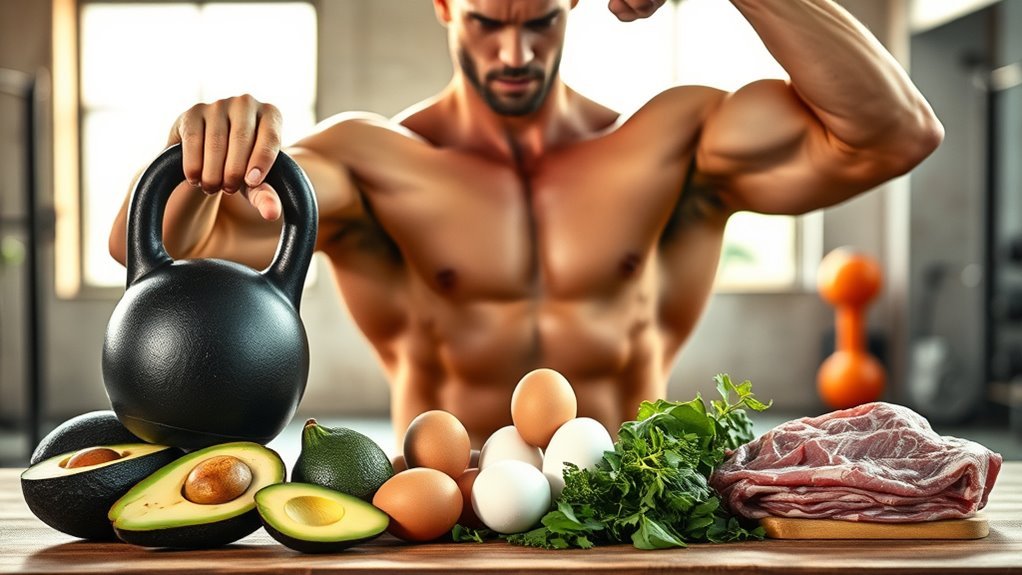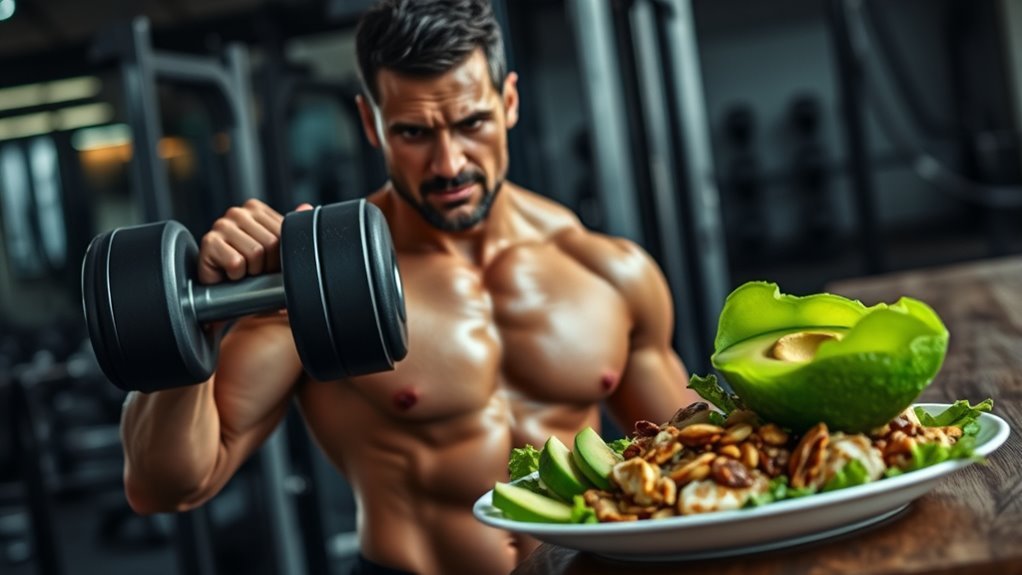Yes, you can build muscle on the keto diet by balancing protein intake, engaging in resistance training, and managing nutrient timing. While it shifts your body’s focus from carbs to fats for energy, maintaining a moderate protein intake (20-25% of daily calories) is key for muscle repair and growth. Combining these strategies with hydration and proper recovery can enhance your results. If you’re curious, there’s more to explore about optimizing your muscle-building journey on keto.
Understanding the Ketogenic Diet

When you explore the ketogenic diet, you’ll find that it’s more than just cutting carbs; it’s a metabolic shift that encourages your body to burn fat for fuel instead of glucose. The keto basics involve greatly reducing carbohydrate intake while increasing fat consumption, prompting your body to enter a state of ketosis. This state allows your body to adapt to using fat as its primary energy source, a process known as fat adaptation. You’ll likely experience increased energy levels and reduced cravings as your body adjusts. However, it’s crucial to be mindful of nutrient balance, incorporating healthy fats and maintaining adequate protein intake. Embracing the ketogenic diet can offer freedom from traditional eating patterns, allowing you to explore new culinary landscapes while pursuing your fitness goals.
The Science of Muscle Building

When building muscle, protein intake plays an essential role in repairing and growing your muscle fibers. It’s also important to understand how your body sources energy, especially on a ketogenic diet, which relies on fats rather than carbohydrates. Balancing these elements can help you optimize your muscle-building efforts while staying within your dietary goals.
Protein Intake Importance
Protein intake plays an essential role in muscle building, especially for those following a ketogenic diet. You need to focus on protein quality, ensuring you consume high-quality sources that provide all essential amino acids. These amino acids are the building blocks of muscle tissue and are vital for repairing and growing muscles after workouts. On a keto diet, where carbohydrate intake is limited, adequate protein becomes even more important to support muscle synthesis and prevent muscle loss. Aim for a balanced intake throughout the day, incorporating foods like lean meats, fish, eggs, and plant-based proteins. This approach not only optimizes your muscle-building potential but also aligns with your goal of maintaining freedom in your dietary choices while achieving fitness results.
Energy Sources for Muscle
While many people associate carbohydrates with energy during workouts, it’s essential to understand how the body adapts to using fat as a primary fuel source on a ketogenic diet. This fat adaptation enhances energy efficiency, allowing you to tap into ketone bodies for sustained performance. Unlike glycogen stores, which deplete quickly, fat offers a more stable energy source, especially beneficial during prolonged activities.
| Energy Source | Benefits |
|---|---|
| Ketone Bodies | Enhanced endurance |
| Fat Adaptation | Increased metabolic flexibility |
| Glycogen Stores | Quick energy for high intensity |
| Nutrient Timing | Optimizes muscle recovery |
| Calorie Surplus | Supports muscle growth |
Emphasizing nutrient timing and maintaining a calorie surplus can further enhance muscle recovery and performance, even under varying workout intensities.
How Keto Affects Protein Intake

When you’re on a keto diet, your protein requirements might shift compared to other eating patterns. It’s crucial to know which protein sources are ideal for muscle building while maintaining ketosis, as well as when to time your intake for the best results. Understanding these factors can help you effectively support your muscle growth while adhering to a low-carb diet.
Protein Requirements on Keto
Understanding your protein requirements is essential for anyone following a keto diet, especially if you’re aiming to build muscle. On keto, you’ll need to focus on the right protein types while ensuring adequate intake for muscle recovery. Here’s what to contemplate:
- Aim for moderate protein intake, typically around 20-25% of your daily calories.
- Choose high-quality protein sources, like lean meats, fish, and eggs.
- Spread your protein intake throughout the day to support muscle synthesis and recovery.
- Monitor your body’s response—adjust your intake based on energy levels and muscle growth.
Optimal Protein Sources
Choosing the right protein sources is essential for maximizing muscle growth on a keto diet, as they not only impact your overall health but also your ability to maintain ketosis. Lean meats and seafood options are excellent choices, providing high protein quality and essential amino acids. Dairy products, like cheese and Greek yogurt, can also be beneficial, thanks to their protein content and healthy fats. Incorporating eggs offers unique benefits, as they’re rich in nutrients and versatile for meal planning. If you prefer plant proteins, opt for low-carb options like tofu or tempeh. Protein powders can fill gaps in your intake, ensuring you meet your goals while maintaining the right balance. Prioritize nutrient timing to optimize muscle recovery and growth.
Timing of Protein Intake
While the timing of protein intake may seem less essential on a keto diet, it plays a significant role in optimizing muscle growth and recovery. Proper meal timing can enhance muscle protein synthesis, especially when considering nutrient timing around workouts. Here are some key points to remember:
- Pre workout snacks should include protein to fuel your workout.
- Post workout nutrition is vital; consuming protein shortly after can help with recovery.
- Protein distribution throughout the day keeps your body in an anabolic state.
- Don’t forget your fasting window; timing your meals can maximize benefits.
Essential Nutrients for Muscle Growth
To build muscle effectively on a keto diet, it’s essential to focus on important nutrients that support both growth and recovery. Prioritizing essential vitamins and maintaining mineral balance is significant. Healthy fats are your primary energy source, while carb cycling can help optimize performance. Implementing hydration strategies and electrolyte management guarantees proper muscle function and recovery.
Here’s a quick overview of important nutrients:
| Nutrient | Function | Sources |
|---|---|---|
| Essential Vitamins | Aid in recovery and energy | Leafy greens, nuts, eggs |
| Healthy Fats | Fuel workouts and muscle growth | Avocados, olive oil, fish |
| Dietary Supplements | Support nutrient gaps | Protein powder, electrolytes |
The Role of Resistance Training
When you’re building muscle on the keto diet, resistance training is essential for maximizing your results. Implementing progressive overload, along with the right frequency and volume, can greatly enhance your muscle growth. Combining your keto approach with a structured weightlifting regimen creates a powerful synergy that supports your fitness goals.
Importance of Progressive Overload
As you commence on a journey to build muscle on the keto diet, understanding the importance of progressive overload in your resistance training regimen is vital. This concept revolves around gradually increasing the demands on your muscles, which is essential for achieving strength adaptations. Here’s how to implement progressive resistance effectively:
- Increase weights: Gradually lift heavier weights as you get stronger.
- Add reps: Increase the number of repetitions for each exercise over time.
- Change tempo: Adjust the speed of your lifts to challenge your muscles differently.
- Alter exercises: Incorporate new movements to target various muscle groups.
Frequency and Volume Matters
While many focus on the intensity of their workouts, the frequency and volume of resistance training play an essential role in muscle building, especially on a keto diet. You’ll want to take into account training frequency and volume manipulation to optimize your results. Higher training frequency can enhance muscle adaptation, ensuring your body responds positively to the stress of workouts. However, don’t overlook recovery time; it’s imperative for muscle repair and growth. Balancing workout intensity with exercise variation helps prevent plateaus and keeps your routine engaging. Incorporating different rep ranges and exercises can stimulate muscles in new ways, promoting further gains. Ultimately, finding the right mix of frequency and volume tailored to your body’s needs will set you up for success on your keto journey.
Combining Keto With Weights
Incorporating resistance training into your keto regimen can greatly enhance muscle development and overall fitness. The weightlifting synergy with keto adaptations can lead to impressive gains, provided you focus on key factors:
- Workout intensity: Gradually increase weights to stimulate muscle growth.
- Exercise frequency: Aim for consistent sessions to maximize results.
- Meal planning: Tailor your diet around your workouts for ideal fuel and recovery.
- Hydration importance: Stay well-hydrated to support muscle recovery and performance.
Consider supplementation strategies, as they can further aid muscle recovery and enhance your results. By combining these elements, you’ll create a balanced approach that promotes muscle growth while enjoying the freedom of the keto lifestyle.
Tips for Optimizing Muscle Gain on Keto
To effectively build muscle on a keto diet, it’s essential to focus on a few key strategies that support both your macronutrient needs and workout regimen. Prioritizing nutrient timing can help maximize your gains; aim to consume protein-rich meals or shakes around your workouts. Also, don’t underestimate recovery strategies—adequate sleep and hydration play crucial roles in muscle repair.
| Strategy | Importance |
|---|---|
| Nutrient Timing | Enhances muscle synthesis |
| Protein Intake | Supports muscle growth |
| Recovery Strategies | Aids in muscle repair |
Common Challenges and Solutions
Shifting to a keto diet can present several challenges when it comes to building muscle, but understanding these hurdles can help you navigate them effectively. Here are some common challenges and their solutions:
- Keto cravings: Combat cravings with high-fat snacks and meal planning.
- Muscle recovery: Focus on nutrient timing and adequate protein intake post-workout to enhance recovery.
- Fat adaptation: Give your body time to adapt; it may take several weeks to efficiently use fat for fuel.
- Hydration strategies: Stay hydrated, as keto can lead to increased water loss, affecting workout intensity and body composition.
Tracking Progress on a Keto Diet
After addressing the common challenges of building muscle on a keto diet, it’s important to focus on tracking your progress to confirm you’re on the right path. Progress tracking helps you stay accountable and motivated. Use measurement techniques like body composition assessments and performance metrics to monitor changes. Consider goal setting, and adjust strategies based on your data logging.
| Date | Body Weight | Performance Metric |
|---|---|---|
| Week 1 | 180 lbs | Squat: 200 lbs |
| Week 2 | 179 lbs | Squat: 210 lbs |
| Week 3 | 178 lbs | Squat: 215 lbs |
| Week 4 | 177 lbs | Squat: 220 lbs |
| Week 5 | 176 lbs | Squat: 225 lbs |
Visual progress can enhance motivation, and involving accountability partners can confirm you stay consistent.
Success Stories: Building Muscle on Keto
While some may doubt the effectiveness of building muscle on a keto diet, numerous success stories illustrate that it’s entirely possible with the right approach. Many individuals have experienced impressive keto muscle transformations by focusing on specific strategies, such as:
Building muscle on a keto diet is achievable with the right strategies and mindset, as proven by many success stories.
- Prioritizing protein intake to support muscle repair and growth
- Incorporating resistance training to stimulate muscle development
- Tracking macronutrients to guarantee peak energy levels
- Staying hydrated and maintaining electrolyte balance for performance
These success stories showcase that with dedication and the right mindset, you can achieve your fitness goals on a keto diet. Embracing this lifestyle doesn’t mean sacrificing muscle gain; instead, it can empower you to build strength while enjoying the freedom of a low-carb approach.
Long-Term Sustainability of Keto for Fitness Goals
As you consider the long-term sustainability of the keto diet for your fitness goals, it’s essential to understand both its benefits and potential challenges. While keto can promote fat loss and muscle preservation, long-term adherence may be difficult for some individuals. To help you weigh your options, here’s a quick overview:
| Pros of Keto Sustainability | Cons of Keto Sustainability |
|---|---|
| Effective for fat loss | Potential nutrient deficiencies |
| Maintains muscle mass | Hard to stick with socially |
| May reduce cravings | Possible energy dips |
Ultimately, your success on keto will depend on your ability to adapt the diet to your lifestyle. Consider how it aligns with your personal goals, preferences, and routine for long-term adherence.


